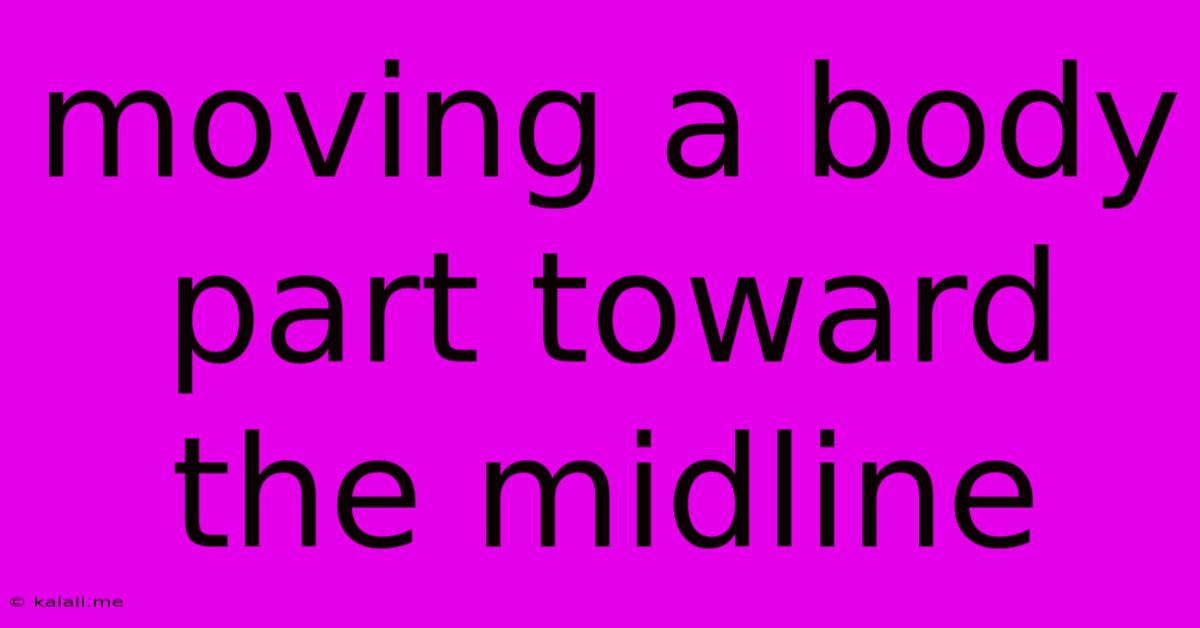Moving A Body Part Toward The Midline
Kalali
Jun 14, 2025 · 3 min read

Table of Contents
Moving a Body Part Toward the Midline: Understanding Adduction
This article explores adduction, the movement of a body part toward the midline of the body. We'll delve into the definition, muscles involved, examples, and potential issues related to adduction. Understanding adduction is crucial for anyone interested in anatomy, kinesiology, or physical therapy.
What is Adduction?
Adduction is the movement of a limb or other body part towards the median plane of the body, or towards the midline of the body. Think of it as bringing something closer to the center. This is in contrast to abduction, which is the movement away from the midline. The median plane is the imaginary vertical plane that divides the body into equal left and right halves. Therefore, adduction always involves bringing a structure closer to this central plane.
Muscles Involved in Adduction:
The specific muscles responsible for adduction vary depending on the body part. Several muscle groups contribute to adduction in different areas:
-
Hip Adduction: The adductor muscles of the inner thigh are primarily responsible for hip adduction. This group includes the adductor longus, adductor brevis, adductor magnus, gracilis, and pectineus. These muscles work together to bring the leg towards the body's midline. Strength and flexibility in these muscles are vital for activities like running, jumping, and even simple walking.
-
Shoulder Adduction: Shoulder adduction involves bringing the arm towards the body. The primary muscles involved here are the latissimus dorsi, pectoralis major, and teres major. These large muscles play a significant role in various movements, including powerful pulling actions and stabilization of the shoulder joint.
-
Finger and Toe Adduction: Smaller muscles within the hands and feet are responsible for the adduction of fingers and toes. These muscles are crucial for fine motor skills and maintaining grip and balance.
Examples of Adduction in Everyday Life:
Adduction is a fundamental movement involved in a wide range of activities:
-
Walking: During the stance phase of walking, the leg adducts to support the body's weight.
-
Closing the Legs: Simply bringing your legs together from a spread position involves hip adduction.
-
Clapping: Bringing your hands together to clap involves shoulder adduction.
-
Writing: The intricate movements of your fingers while writing involve adduction and abduction in quick succession.
Potential Issues Related to Adduction:
Problems with adduction can stem from various causes:
-
Muscle Imbalances: Weakness or tightness in the adductor muscles can lead to poor posture, pain, and decreased athletic performance.
-
Injuries: Strains or tears in the adductor muscles are common athletic injuries, often occurring during activities that involve sudden changes in direction or forceful movements.
-
Neurological Conditions: Certain neurological conditions can affect the nerves that control the adductor muscles, leading to weakness or paralysis.
-
Joint Problems: Problems with the hip, shoulder, or other joints can also restrict adduction.
Improving Adduction:
Improving adduction strength and flexibility can be achieved through targeted exercises. These could include:
-
Adductor stretches: Gentle stretches targeting the inner thigh muscles.
-
Strengthening exercises: Exercises that specifically target the adductor muscles, such as side leg raises or adductor machine exercises.
-
Pilates and Yoga: These practices often incorporate exercises that improve both strength and flexibility in the adductor muscles.
Understanding adduction, its associated muscles, and potential problems is essential for maintaining good physical health and optimal performance. Consulting with a physical therapist or healthcare professional can provide personalized advice on exercises and strategies to improve adduction and address any specific concerns.
Latest Posts
Latest Posts
-
Which Of The Following Is Not An Si Unit
Jun 15, 2025
-
A Flowing Artesian Well Is One That
Jun 15, 2025
-
Which Of The Following Is A Consequence Of Deforestation
Jun 15, 2025
-
Which Of The Following Is True About Cash Crops
Jun 15, 2025
-
What Factors Affect The Speed Of A Wave
Jun 15, 2025
Related Post
Thank you for visiting our website which covers about Moving A Body Part Toward The Midline . We hope the information provided has been useful to you. Feel free to contact us if you have any questions or need further assistance. See you next time and don't miss to bookmark.